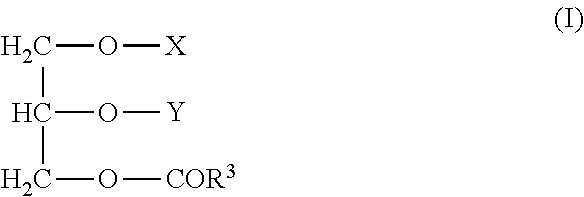Alkali metal and alkaline earth metal glycerates for the deacidification and drying of fatty acid esters
a technology of alkali metal and alkaline earth metal, which is applied in the field of compositions, can solve the problems of increasing costs, unable to reach, and the capacity of a reactor is reduced, and achieves the effect of reducing the number of fatty acids
- Summary
- Abstract
- Description
- Claims
- Application Information
AI Technical Summary
Benefits of technology
Problems solved by technology
Method used
Image
Examples
examples
[0074]The content of alkali metal glycerates is determined by potentiometric titration. In this, the glycerate is dissolved in demineralized water by stirring for 5 minutes and titrated with 0.25 molar sulfuric acid measuring solution to the equivalence point.
[0075]The water content is determined in accordance with DIN 51777 “Determination of the water content by the Karl-Fischer-direct method.” The solvent is methanol, the detection takes place amperometrically at a double platinum electrode.
[0076]The soap content is ascertained by titration according to the standard method of the DGF (German Society for Fat Science), Method C-III 15 (97) “Soap in Oils and Fats,” published in “German Standard Methods for Investigating Fats, Fat Products, Surfactants and Related Substances.” Here, the sample is dissolved in ethanol or acetone and titrated with 0.1 molar hydrochloric acid against bromophenol blue as indicator. Alternatively, the end product can be ascertained potentiometrically.
[0077...
PUM
| Property | Measurement | Unit |
|---|---|---|
| temperatures | aaaaa | aaaaa |
| temperatures | aaaaa | aaaaa |
| temperatures | aaaaa | aaaaa |
Abstract
Description
Claims
Application Information
 Login to View More
Login to View More - R&D
- Intellectual Property
- Life Sciences
- Materials
- Tech Scout
- Unparalleled Data Quality
- Higher Quality Content
- 60% Fewer Hallucinations
Browse by: Latest US Patents, China's latest patents, Technical Efficacy Thesaurus, Application Domain, Technology Topic, Popular Technical Reports.
© 2025 PatSnap. All rights reserved.Legal|Privacy policy|Modern Slavery Act Transparency Statement|Sitemap|About US| Contact US: help@patsnap.com


